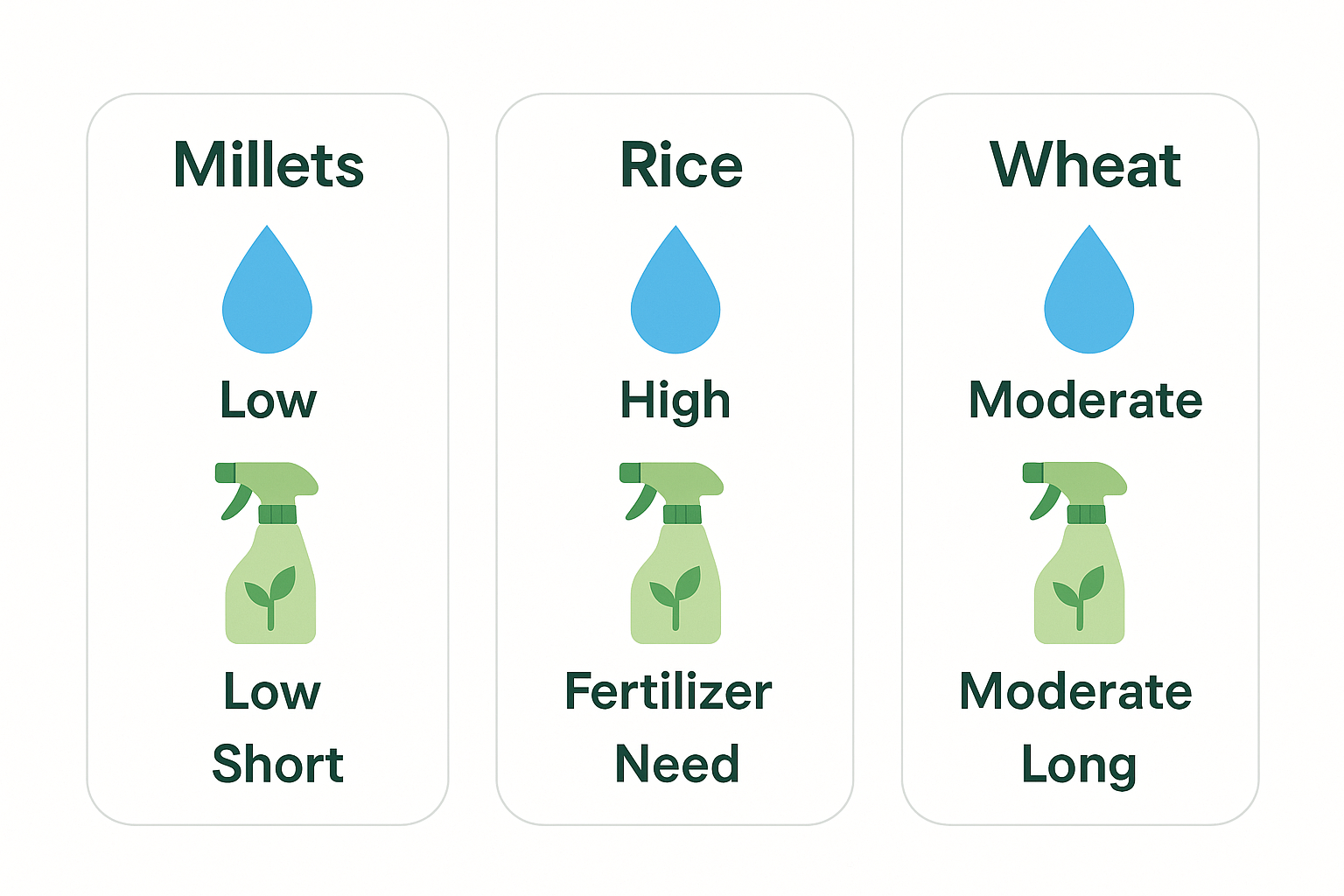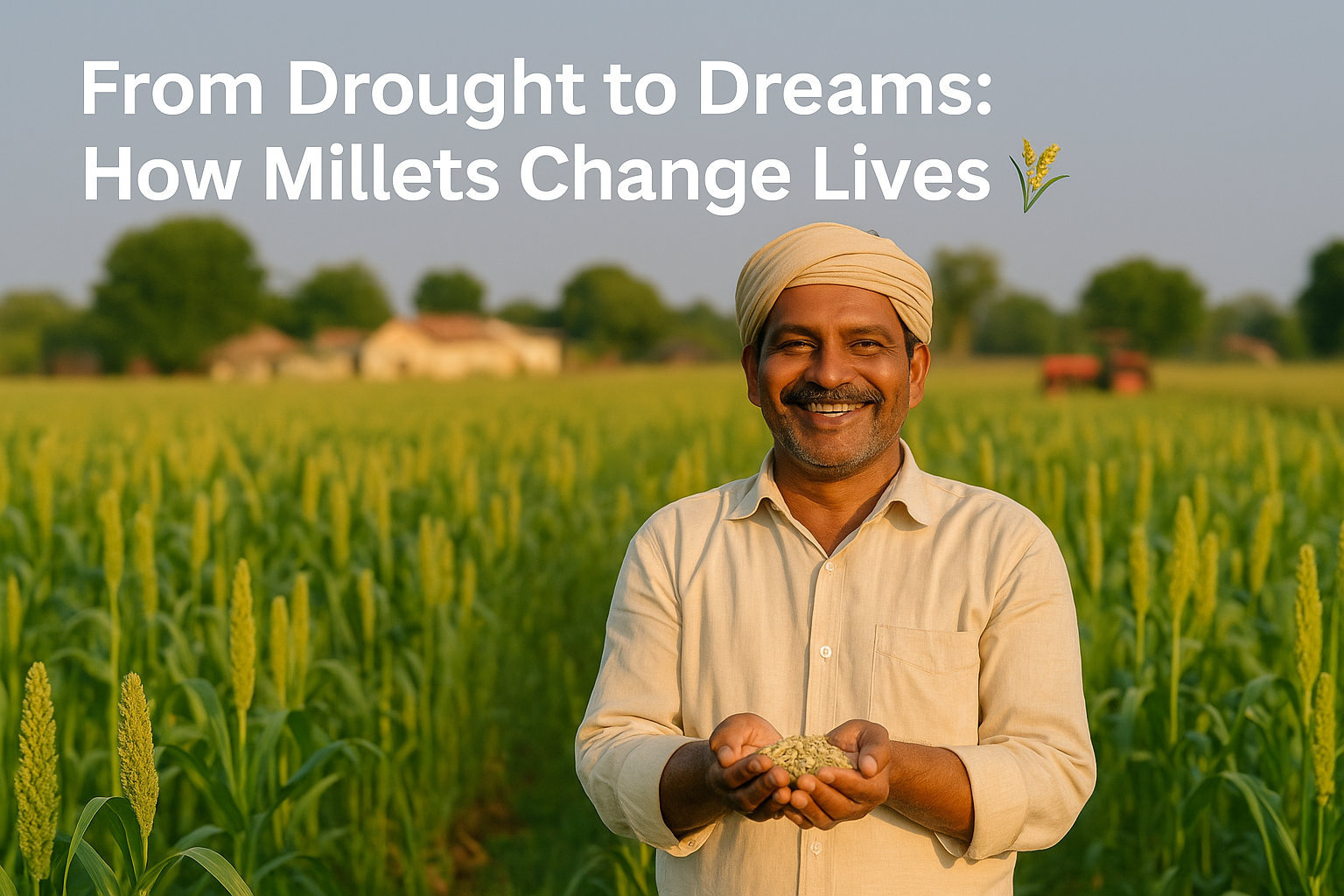Before they’re tiny grains in a bowl, millets can be small powerhouses with the potential to change a farmer’s luck. India’s small and marginal farmers are threatened with insufficient rains and robbing soil fertility, but few crops come with simpler specimens than the millets. They can do very well in dry and rocky soil, don’t need superpower fertilizers, and some can withstand rain on their feet. That’s one big reason how millet cultivation helps Indian farmers survive and even thrive in uncertain weather.
You know what’s cool? Millets are super adaptable. They can grow where rice or wheat can’t and that’s a real blessing for farmers in drought-prone areas. They mature quickly, too, some in only—not more than two or three months—farmers get quicker returns and more air to develop other food plants or livestock. It’s like having an extra safety net when things go south with the monsoon. And they don’t need much work; even if they are little pampered, they still do well. Kind of like that low-maintenance friend who always shows up when you need them.
Apart from that, millets are getting some major urban love. With the weight-watching crowd gradually eating millets over worries of better processing, lower GI counts, and more lasting energy, you have a new fad in your maintenance. And that implies that you will also have higher values. Millet cultivation is the most excellent way to describe how it supports Indian farmers because you are not just building foods but more than a chance. Whether you reduce your costs by using more water and seeds or discover money by opening up new markets, a gathering of hope floats over the tale of the countryside’s harvest once again.
Bottom line — millets aren’t old-fashioned anymore. They’re smart, sustainable, and strong. And for millions of farmers across India, that makes all the difference between just surviving and truly thriving.
What Are Millets and Their Role in Indian Farming
Small-seeded grains, millets are old-school but gold-standard crops in India. They have been around for thousands of years, well before rice and wheat claimed the trophy. Their robust, rapid growth and abundant nutrition have endeared them to farmers. Moreover, millets are easy to grow and require far less pampering – they need less water, fewer fertilizers, and can yield a sum even if the weather plays spoilsport.
Here’s a quick look at the main types of millets grown in India:
| Type of Millet | Common Name | Major Growing States | Main Benefit |
| Ragi | Finger Millet | Karnataka, Tamil Nadu | Rich in calcium |
| Bajra | Pearl Millet | Rajasthan, Gujarat | Great for dry soil |
| Jowar | Sorghum | Maharashtra, MP | High in protein |
| Foxtail | Kangni | Andhra, Telangana | Fast-growing |
| Kodo | Kodra | Chhattisgarh, Odisha | Good for diabetics |
Millets are a big deal, and they do more than you know to keep farming in India eco-friendly and less risky. They’re good for crop rotation, preventing the soil getting tired, maintaining the farm lands even in drought. In short, they’re the best buds you’ve known — sturdy, straightforward and committed to the cause whenever rough time comes!
Drought-resilience: Millets Thrive in Harsh Conditions
Millets are like the tough guys of the crop world. When rain plays hide and seek, they still stand tall. Most other grains, like rice or wheat, wilt when water runs low, but millets? Nope, they just keep growing. That’s a big reason why farmers in dry states love them so much. These little grains don’t panic when the heat hits hard or the soil turns rough.

Here’s why millets are total drought heroes:
| Feature | How It Helps Farmers |
| Deep Root System | Reaches underground water easily |
| Short Growing Period | Needs less rainfall overall |
| Low Water Requirement | Uses 70–80% less water than rice |
| Grows in Poor Soil | No fancy soil or heavy fertilizer needed |
Many Indian farmers in Rajasthan, Gujarat, and Telangana depend on millets during bad monsoon years. The crops can grow even if the rain shows up late or leaves early. Sometimes, fields look dry as dust, but millets still pop up like magic. That’s kinda cool, right? While other crops cry for water, millets just shrug and keep going. They prove that small seeds can handle big problems with a smile.
Low-input Costs: Millets Reduce Production Expenses
One big reason farmers are turning to millets is because they don’t cost a bomb to grow. These crops are kinda like those smart spenders who know how to stretch every rupee. You don’t need fancy seeds, costly fertilizers, or heavy irrigation setups. Millets do just fine with basic care and natural soil. That’s a huge sigh of relief for small farmers who can’t afford high farming bills every season.
Here’s how millets help farmers save money:
- Need very little water compared to rice or wheat.
- Grow well even in poor soil, so less spending on soil treatment.
- Use fewer fertilizers and pesticides, sometimes none at all.
- Local seeds are cheaper and easy to reuse next year.
- Simple tools and labor are enough for cultivation.
Because of these things, the overall production cost drops by almost half in some areas. That’s big when margins are thin. And you know what’s cool? Even if the market price dips, farmers still manage to earn something. Millets keep their wallets safe and their fields green. Pretty neat, right? A crop that saves money and the planet—now that’s a solid deal for Indian farmers.
Shorter Cropping Cycles and Multiple Cropping
Millets are fast movers in the farming world. While some crops take ages to grow, millets wrap up their cycle in just 60 to 90 days. That’s like finishing a full season before others even start stretching! This quick turnaround means farmers don’t have to wait long for income. They can grow millets, sell them, and still have time for another crop in the same field. Pretty handy, right?
Here’s how millets make multiple cropping easy:
- Short growing season allows two or three crops a year.
- Farmers can rotate millets with pulses or oilseeds easily.
- Helps maintain soil fertility and reduce pest attacks.
- Makes better use of land and available rainfall.
- Reduces financial risk since income comes in more cycles.
Many farmers in states like Karnataka and Madhya Pradesh mix millets with other crops like lentils or peanuts. It’s like not putting all your eggs in one basket. Even if one crop fails, the other keeps the balance. That’s how millets help farmers stay on their feet, rain or shine. Short crop cycle, more harvests, and steady income — that’s a sweet deal any farmer would happily grab.
Better Soil Health and Ecosystem Benefits
Millets are like nature’s best friends. They don’t just feed people, they feed the soil too. These hardy crops grow deep roots that hold the soil together and stop erosion. Even when heavy rains wash away top layers in other farms, millet fields stay put. The soil feels stronger and richer after every harvest. That’s something most modern crops can’t brag about.
Here’s how millets help keep the ecosystem happy:
- Their roots improve soil structure and trap nutrients.
- Need less fertilizer, which means fewer chemicals in the land.
- Add organic matter back to the soil after harvest.
- Perfect for crop rotation, keeping the soil alive and healthy.
- Attract birds and insects that help balance the farm ecosystem.
🧠 Did you know? Millets use 70% less water than rice and can grow on infertile land, making them ideal for India’s changing climate.
Farmers say their fields look “fresh” after a millet season. The soil becomes soft, easier to plough, and holds moisture better. It’s like giving the land a break while still earning from it. In some areas, even after years of continuous farming, millet fields haven’t lost fertility. That’s kinda amazing, right? Millets don’t just grow food, they grow life — and that makes them a blessing for farmers and the planet alike.
Market Potential: Domestic & Export Opportunities
Millets are no longer the “poor man’s food” like people used to think. Now they’re showing up on supermarket shelves, hotel menus, and even export lists. From ragi biscuits to millet noodles, the demand is growing like crazy. That shift is opening huge doors for farmers. And honestly, it’s about time millets got their spotlight moment!
Here’s how the millet market is booming:
- Urban consumers are switching to millets for health and fitness.
- Food companies are adding millet snacks, flours, and cereals.
- Government promoting “International Year of Millets” to push exports.
- Export demand rising from countries like USA, UAE, and Singapore.
- Value-added millet products fetch better prices for farmers.
Government Support for Millet Cultivation in India

The Indian government is giving millets a big thumbs-up. Seeing how strong these crops are for both farmers and the planet, a lot of new programs are rolling in. The idea is to make millets mainstream again and boost farmer income while doing it. Pretty neat, right?
Here’s how the government is helping millet farming:
- The National Mission on Nutri-Cereals (NMoNC) supports better seeds and training.
- Millets are now part of the Public Distribution System (PDS).
- The Year 2023 was declared International Year of Millets to raise awareness.
- Subsidies are given for millet processing and machinery.
- States like Karnataka, Telangana, and Odisha got extra support for millet projects.
Financial Security for Small and Marginal Farmers
For small and marginal farmers, every rupee counts. Millets give them a way to earn steady income without burning pockets. These crops don’t demand much — less water, less fertilizer, and fewer risks. Even when the weather acts moody, millets still manage to grow fine. That’s why they’re becoming a real game changer in rural India.
Here’s how millets boost farmer security:
| Factor | How It Helps Farmers |
| Low Investment | Needs fewer inputs like water and chemicals |
| Steady Returns | Grows even in weak monsoon seasons |
| Local Markets | Easy to sell in nearby towns or co-ops |
| Less Debt | Farmers avoid taking heavy loans |
| Food Security | Keeps families fed during tough times |
Value-Addition: Processing, Branding and Higher Returns
Millets don’t have to stop at the farm gate. With a bit of creativity, farmers can turn these humble grains into high-value products that sell like hotcakes. Processing and branding millets have become a big trend lately.
Here’s how value-addition helps farmers earn more:
- Processing adds extra income through local units or FPOs.
- Branding makes millet products look modern and healthy.
- Packaged millet foods attract city customers easily.
- Farmers get better shelf life and larger markets.
- Government gives support for small processing centers.
Challenges Farmers Face in Millet Cultivation
Even though millets sound like the perfect crop, farmers still face a bunch of hurdles while growing them. It’s not always smooth sailing, you know. The problems may not be huge one by one, but together, they can make farming tough for small growers.
Here are some common challenges millet farmers deal with:
- Lack of proper storage and milling units in rural areas.
- Low market prices in some regions due to weak demand.
- Poor awareness among consumers about millet benefits.
- Limited access to high-quality seeds and modern tools.
- Few buyers or middlemen offering fair rates to farmers.
Best Practices for Farmers to Succeed with Millets
Millets grow well, but following a few smart steps increases the quantity and quality of the harvest. Theses practices reduce the period of loss and improve the efficiency and output in the farm. It’s like giving your farm a little bit of care and diligence, and it gives you double in return.
Here are some simple best practices for millet farming:
- Choose local, drought-tolerant millet varieties suited for your soil.
- Prepare soil with organic manure to boost fertility naturally.
- Follow mixed cropping with pulses or legumes to balance nutrients.
- Weed early and use bio-pesticides to control pests safely.
- Harvest at the right time when grains are dry and golden.
- Store grains in cool, dry places to avoid moisture loss.
The Future: Millets in a Climate-Smart Indian Agriculture
The future of Indian farming seems sort of promising with millets. As weather patterns become more erratic and freshwater resources grow more sparse, farmers require plant varieties that could withstand the scorching sun. In other words, millets are climate-smart farming’s superheroes. They not only withstand difficult times, but they also prosper.
Here’s why millets fit perfectly in India’s climate-smart future:
- Grow well in low-rain and heat-prone regions.
- Require less fertilizer and water, saving natural resources.
- Improve soil health for long-term sustainability.
- Help farmers cut costs and reduce carbon footprint.
- Support biodiversity by bringing back traditional grains.
Millets as a Win-Win for Farmers and Food Security
Hidden in plain sight like tiny treasures, millets have been part of India’s food culture for centuries, and now they are making a grand comeback, and it is for the right reasons. For the farmers, they signal hope and stability. For people, health and nutrition. It is a perfect win – a win situation where the soil and the stomach are perfectly satisfied.
The biggest strength of millets for farmers India is that they grow with little water and fewer resources. Even in rough weather, they don’t give up easily. That means steady income and less risk, especially for those with smaller farms. When you look at the benefits of millet farming for small farmers in India, it’s clear—these grains save money, boost food supply, and create jobs in rural areas.

